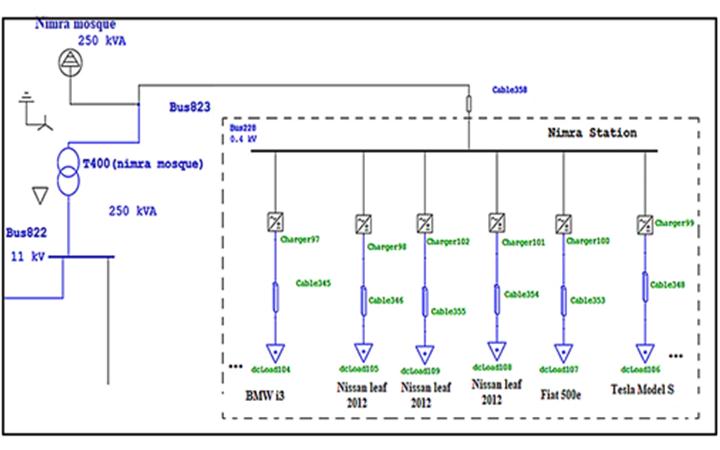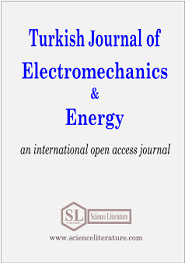
The future of the Hebron electrical grid with growing demand for electric cars
Abstract
This article studies the future state of the electrical network in Hebron city when seven electric car charging stations will be established in the city. The main aim of the research is to develop and improve the capacity of the network for accommodating the presence of charging car stations on it. Four different types of Electric Vehicles (EVs) will be tested, the EVs contain batteries of different capacities and different charging technology as well as various charging levels. 58 cars in the peak period of demand in all charging stations will be assumed. Consequently, in this period the research focus on the total demand in each electric substation and losses in the grid of the city. The Electrical Transient Analyser Program (ETAP) will be used to apply this study. The main result is the network of the city will face some overloading problems at maximum demand of charging. This paper also presents some practical procedures for solving the expected overloading in the network.
Full Text:
PDFReferences
C. Saber, “Analysis and optimization of the conducted emissions of an on-board charger for electric vehicles,” Ph.D. Thesis, Université Paris-Saclay, 2017.
W. Kempton and J. Tomić, “Vehicle-to-grid power fundamentals: Calculating capacity and net revenue”, Journal of Power Sources, 144(1), pp. 268-279, 2005.
S. Berisha, G. Karady, R. Ahmad, R. Hobbs, & D. Karner. “Current harmonics generated by electric vehicle battery chargers,” in Proc. of the International Conference on Power Electronics, Drives and Energy Systems for Industrial Growth, New Delhi, India, 8-11 Jan. 1996.
N. A. Iqteit, A. B. Arsoy, B. Çakir. “A simple method to estimate power losses in distribution networks,” in Proc. of the 2017 10th International Conference on Electrical and Electronics Engineering (ELECO), Bursa, Turkey, 30 Nov.-2 Dec. 2017.
N. Iqteit, A. Basa Arsoy, B. Cakir, “Load Profile-Based Power Loss Estimation for Distribution Networks,” Electrica, 18(2), pp. 275-283, 2018.
M. Carrión, R. Zárate-Miñano and R. Domínguez, “Integration of Electric Vehicles in Low-Voltage Distribution Networks Considering Voltage Management”, Energies, vol. 13, no. 16, p. 4125, 2020.
M. Duke, D. Andrews, and T. Anderson, “The feasibility of long-range battery-electric cars in New Zealand”, Energy Policy, 37(9), pp. 3455-3462, 2009.
T. Wilberforce et al., “Developments of electric cars and fuel cell hydrogen electric cars”, International Journal of Hydrogen Energy, 42(40), pp. 25695-25734, 2017.
D. Sandalow, A. Hove. “Electric Vehicle Charging in China and the United States”, Feb. 5, 2019. [Online]. Available: https://www.energypolicy.columbia.edu/ [Accessed: March. 16, 2022].
R. Hanifah, S. Toha and S. Ahmad, “Electric Vehicle Battery Modelling and Performance Comparison in Relation to Range Anxiety,” Procedia Computer Science, vol. 76, pp. 250-256, 2015.
N. Iqteit, K. Yahya, and S. A. Khan, “Wireless Power Charging in Electrical Vehicles”, in Wireless Power Transfer – Recent Development, Applications, and New Perspectives. London, United Kingdom: IntechOpen, 2021.
Transportation Research Board and National Research Council, “Overcoming Barriers to Deployment of Plug-in Electric Vehicles,” Washington, DC, The National Academies Press, 2015.
G. Ombach, J. Junak. “Weight and efficiency optimization of auxiliary drives used in automobile”. in Proc. of the XIX International Conference on Electrical Machines (ICEM 2010), 8-11 Jan, Rome, Italy, 1996.
V. Monteiro, B. Exposto, J. G. Pinto, R. Almeida, J. C. Ferreira, A. A. Nogueiras Melendez & J. L. Afonso, “On-board electric vehicle battery charger with enhanced V2H operation mode,” in Proc. of the IECON 2014 - 40th Annual Conference of the IEEE Industrial Electronics Society, Dallas, TX, USA. 29 Oct.-1 Nov, 2014.
Y. Kongjeen, K. Bhumkittipich, “Impact of Plug-in Electric Vehicles Integrated into Power Distribution System Based on Voltage-Dependent Power Flow Analysis,” Energies, 11(6), p. 1571, 2018.
H. Xu, S. Miao, C. Zhang, and D. Shi, “Optimal placement of charging infrastructures for large-scale integration of pure electric vehicles into the grid,” International Journal of Electrical Power & Energy Systems, vol. 53, pp. 159-165, 2013.
H. Cai, X. Jia, A. Chiu, X. Hu, M. Xu, “Siting public electric vehicle charging stations in Beijing using big-data informed travel patterns of the taxi fleet”, Transportation Research Part D: Transport and Environment, vol. 33, pp. 39-46, 2014.
M. Hodgson, “A Flow-Capturing Location-Allocation Model”, Geographical Analysis, 22(3), pp. 270-279, 2010.
Z. Liu, F. Wen, and G. Ledwich, “Optimal Planning of Electric-Vehicle Charging Stations in Distribution Systems”, IEEE Transactions on Power Delivery, 28(1), pp. 102-110, 2013.
R. M. Kumar, V. P. “Modelling and Analysing of the Impact of Charging Plug-in Electrical Vehicles on Residential Distribution Grid,” International Journal of Applied Science and Mathematics, 3(2), pp. 93-99, 2016.
N. Iqteit, A. Basa Arsoy and B. Çakir, “A time‐varying load‐based analytical approach for DG optimization in the distribution network,” International Transactions on Electrical Energy Systems, 29(4), pp. e2783, 2018.
Hebron Electric Power Co. (HEPCo). [Online]. Available: https://www.hepco-pal.com/main/ [Accessed: March. 16, 2022].
BU-1003: Electric Vehicle (EV) – Battery University. [Online]. Available: https://batteryuniversity.com/ [Accessed: March. 16, 2022].
M. Kane. “33 kWh BMW i3 and 30 kWh Nissan LEAF Fast Charging Comparison”, Aug 19, 2016. [Online]. Available: https://insideevs.com/news/ [Accessed: March. 16, 2022].
NCR18650 datasheet, “Lithium ion battery”, Dec. 2011. [Online]. Available: https://datasheetspdf.com/ [Accessed: March. 16, 2022].
URN: https://sloi.org/urn:sl:tjoee71216
Copyright (c) 2022 Turkish Journal of Electromechanics and Energy

This work is licensed under a Creative Commons Attribution-NonCommercial 4.0 International License.

 Indexed in:
Indexed in:
















